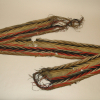Relatives/Heritage items
Displaying 2901 - 2920 of 4694 Relatives
Browsing allows you to see all the records for relatives and heritage items in the GKS. You can also search by material made, and/or filter by nations. To search by material made, type the material's name, by example 'leather', in the box below and click “Apply.” You can select multiple nations from the dropdown list by pressing “Ctrl” (on PC) or “Command” (on Mac) and clicking, then select “Apply.”
A blue stroud bag with panel of woven glass beadwork in geometric designs, probably Mushkegowuk, Eeyou, or Metis. Given to Major Stack of the 24th regiment to the Royal Dublin Society.
A red catlinite pipe bowl with lead inlay and circle motifs, Great Lakes, first half of the 19th century
A red woolen sash, commercially produced probably in England, for military use. May have been presented as a part of a diplomatic gift exchange to an Aboriginal leader
These relatives, a pair of moccasins, are of one-piece construction with centre vamp seam and quill decoration on cuffs, centre seam, and heal seam. Although the origins of these relatives are not certain, they are probably Anishinaabe, dating to the late 18th or early 19th
This relative, a bag, is decorated with two horizontal zones of quill embroidery and fringes of red woollen yarn. Although the origins of this bag are not certain, it was likely made in the late 18th or early 19th century and has probable ties to
These relatives, a pair of red woollen leggings, feature floral beadwork on both sides of the flaps. Although the origins of the leggings are not certain, they have probable Cree connections and likely date to 1850 to 1900.
These relatives currently resides in the National
These relatives, a pair of brown woolen leggings, boast ribbonwork applique on the flaps. The flaps are not lined, and the tape used for ties has been cut and bound on one edge with green yarn. The origins of the leggings are not certain; however
A string of wampum beads identified with Sauk chief Black Hawk,early 19th century
A Huron-Wendat moosehair embroidered birchbark tray with figures, birds and flowers, transferred from the Royal Botanic Gardens, Glasnevin, second half of the nineteenth century.
These relatives, a pair of finger-woven garter pendants, are composed of blue wool with white glass beads that have been interwoven in opposed zigzags and other motifs. Tassels at the end of each pendant feature quill-worked red-dyed deer hair tassels threaded through iron-tinned cones. Although
A burden strap with moosehair embroidery in geometric designs, probably Hodenosaunee or Huron-Wendat
This relative, a red finger woven sash, features yellow bands created by resist or mordant technique, which are interwoven with glass beads in large, bold hourglass and diagonal lines that suggest thunderbird and 'bird track' patterns. Although the origin of this relative is uncertain, it
A string of red rounded beads found in East Cayuga, Old Town, New York, probably 17th century, Hodenosaunee
This relative, a ceinture fleche or sash, is composed of red, brown, light blue, olive green, and white three-ply yarn that forms a v-shaped or arrowhead pattern. Although its point of origin is uncertain, it is probably of French-Canadian design and manufacture.
This relative currently
This relative, a single moccasin, is composed of commercially tanned hide, pink polished cotton lining, red cotton tape, and moosehair. The moccasin is embroidered with quills in floral motifs. Donated by the Duke of Leinster (Maurice FitzGerald, 6th Duke of Leinster), the moccasin's origins are
This relative, a single garter or arm band, is composed of hide with quill wrapped splints and red dyed deer hair. The design of the garter/band is a checkerboard pattern. The thongs at one end of the garter/band are capped with metal cones, as well
This relative, a single moccasin, is composed of a high cuff and centre seam construction that is covered with zigzag band quillwork and some moose hair. The design of quillwork includes 'Cane' or opposed hook motifs similar to the motifs found on late 18th century
This relative, a wampum belt, includes a thin purple zigzag design on a white ground made of purple and white quahog shell. Fourteen rows of beads wide, the belt's weft is composed of vegetable fibre and the warp of two-ply hemp or cotton. The ends
This relative, a fragment of a ceremonial or sacred bag, is made of the head of an otter. Decoration includes red and black netted quillwork, including 9 rows at its widest point, 5 rows at its most narrow. There are five tassels at the end
This relative, a finger woven garter pendant, is composed of interwoven white glass beads, green and red yarn, and deerhair forming zigzag and diamond motifs. Nine tassels adhered at one end, bound by white, red, and black porcupine quills and tipped with tinned metal cones
 Knowledge Sharing Platform
Knowledge Sharing Platform




















